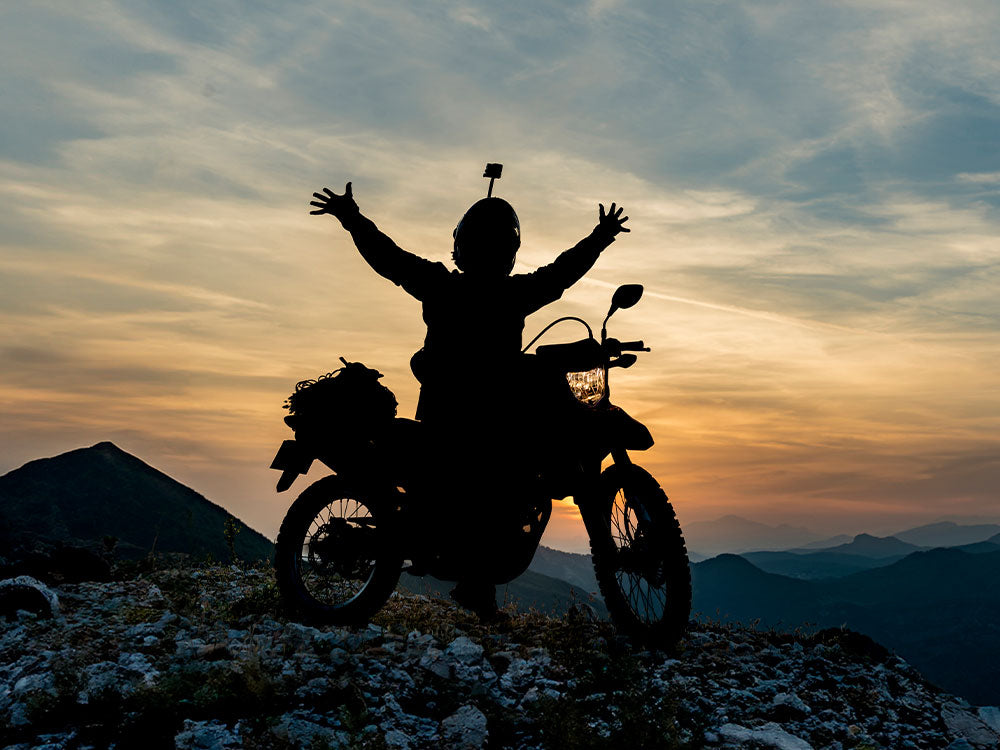
It is not uncommon for motorcycle riders to spend more time riding when trying to reach their destinations faster. However, they take fewer breaks as a result. There is enough research-based evidence to show that over-ambitious riding goals and less rest breaks cause fatigue, a common cause of road accidents. Moreover, riding without taking a break may cause your motorcycle to break down or make you sick.
This article discusses how taking breaks during motorcycle trips wards off fatigue and ensures safer riding.
Table of Content
1. Why Plan Rest Breaks During Motorcycle Trips?
According to the National Highway Traffic Safety Administration, 90,000 road accidents in the U.S. were due to tired and sleepy riders. Every year 50,000 major injuries and 800 fatalities are reported in the United States.
VicRoads, an Australian road safety organization, confirmed that 20% of road accidents are due to sleep deprivation and fatigue.
Similarly in Bavaria, Germany, a research study conducted on motorway crashes claimed that 35% of fatal highway accidents were due to rider fatigue.
It is possible to reduce the frequency of fatal road accidents by taking regular breaks during motorcycle trips.
According to the Motorcycle Safety Foundation, riders should take plenty of breaks to rest, rehydrate, eat, and nap to alleviate fatigue.
2. Determine the Right Hours for Rest Breaks
Due to the human body’s natural circadian rhythm, people often feel tired and less alert during the early morning and mid-afternoon. A rider who has been riding all day is more at risk of fatigue-related road crashes after midnight between 1 a.m. - 6 a.m. and in the mid-afternoon between 3 p.m. -7 p.m.
According to the Insurance Institute for Highway Safety, most fatal road accidents in the U.S. occur between 5 pm. - 7 p.m. and the most dangerous time for highway riding is between 12 a.m. - 4 a.m.
Therefore, it is best to plan rest breaks during these hours to avoid accidents.
3. How Often Should You Plan Rest Breaks?
Experienced riders always recommend taking a 15-minute break every 90 minutes. During the hours when there is a higher risk of getting into an accident, you should take 20-minute breaks every 60 minutes. Try to be consistent with your break interval schedule. Contrary to popular belief, taking breaks will help you reach your destination faster than riding constantly without breaks.
If you are a beginner or an intermediate rider, follow the 15-minute break every 90 minutes rule.
Veteran riders can adjust their break interval schedule according to what works best. However, it is recommended that they take a 15-minute break every 2-3 hours.
4. How Many Hours Should You Ride in a Day?
With frequent breaks, try to limit your riding time to 9 hours to prevent the risk of becoming fatigued. If you take a 15-minute break every 90 minutes, your overall riding time should be about 6.5-7 hours long, and your rest period should be 2-2.5 hours long.

5. Coffee-Nap - The Most Effective Riding Break Strategy?
According to a research study published in the Journal of the Society for Psychophysiological Research, 15-minute naps and caffeine breaks greatly reduce riding fatigue and help riders stay more alert and active.
Another interesting research study conducted at Loughborough University, taking a nap immediately after a cup of coffee can improve your brain functionality, situational awareness, and reaction time. The study reveals that caffeine takes at least 20 minutes to take effect. If you drink coffee and nap for 15 minutes immediately after, the effect of the stimulant will be strongest a couple of minutes after you wake. Researchers have derived the term “coffee-nap” to explain this phenomenon.
6. What to Do During Rest Breaks?
The purpose of rest breaks is to prepare yourself for the next leg of your trip. Therefore, it is best to engage in activities that will help you recharge and replenish your energy to help you stay awake and alert. Here are a few things you can do while taking a rest break:
6.1 Perform Stretching Exercises
Stretching or light exercises can help with muscle stiffness, improve blood circulation, and keep you from falling asleep. Staying in the same posture for too long can result in painful muscle cramps. Even if you are not feeling any discomfort, make sure you stretch your legs, back, neck, and arm muscles to avoid joint pain, soreness, and fatigue. Stretching also improves mental clarity and alertness, allowing riders to make quick decisions and react in time to danger.
6.2 Adjust Your Riding Gear & Ear Plugs
Do not hesitate to take a break to change your riding gear to better suit the weather. Throughout your trip, you may experience changing weather conditions and temperatures. If you start your trip in the morning, the temperature will be cooler and require you to wear extra layers of clothing. As the sun continues to rise, the temperature should become warmer. If you encounter rain, it is prudent to stop and change your riding gear accordingly.
In addition, you should adjust your earplugs every time you stop to better protect your ears from loud noises. The noise of wind and exhaust can be deafening, causing irritation and mental fatigue. If your ears are being deafened by the surrounding noise, adjust them accordingly to ensure a more comfortable ride.
6.3 Food, Water, & Toilet Breaks
During your motorcycle trip, eat light meals often and drink plenty of water at every stop. Motorcycling is a physically demanding activity that requires a lot of energy. Eat at least 3-4 light meals or two balanced meals to prevent riding on an empty stomach.
Some riders keep their food and water intake to a minimum to avoid having to stop to go to the bathroom. However, this is not recommended since you will become hungry or dehydrated. If you feel you have less energy, do not wait until later to fill up on food and water.
6.4 Refill Your Fuel Tank
Never ride your motorbike until its fuel tank is almost running empty. The last thing you want is to be stranded several hundred miles away from the nearest gas station. Though it varies depending on the type of motorcycle you ride, it is recommended you refuel every 100-150 miles or every three hours.
6.5 Connect with Yourself & Family Members
These short breaks provide opportunities for self-reflection. You can write journals, record a video, or take photographs to capture the highlights of your trip. You can also use these breaks to further plan the next steps of your trip. Consider contacting your family to inform them about your well-being and progress on the road.
6.6 Visit Popular Truck Stops
Roadside pit stops or truck stops are the best places to enjoy hearty breakfasts, buy souvenirs, and make new friends. You can also go to truck stops for new clothes, showers, flat tire repairs, and ATMs.
6.7 Make the Trip Enjoyable for the Passenger
If you are riding with a passenger, you can make the trip more comfortable and enjoyable by taking breaks. Discussing the road, rest stops, and planned activities will help keep your passenger engaged during your trip. An alert and energetic passenger will help keep you from falling asleep, missing hazard signs, or getting into an accident.
7. How Do Rest Breaks Benefit Your Motorcycle?
Modern motorcycles feature powerful engines that ensure consistent horsepower and torque when traveling across long distances. However, your motorcycle’s engine will need time to cool down, especially if you are riding in warm weather conditions. Frequent breaks will allow your motorcycle to maintain good mileage and increase the engine’s lifespan.
8. Frequently Asked Questions
8.1 How to Take a Power Nap During a Motorcycle Trip?
Here are a few ways you can take a power nap during your motorcycle trip:
- Put down the center stand and lay across the back of the bike to take a nap.
- Carry a sleeping pad with you to rest on whenever you need to.
- If you can find an outdoor rest area, you can rest on the tables after asking for permission.
8.2 Where to Stop for a Break During Motorcycle Trips?
Besides stopping at gas stations, riders can stop at roadside diners, rest areas, and organized campgrounds. You can use GPS, motorcycle trip planning apps, and Google Maps to find rest areas near you.
9. Takeaway
During motorcycle trips, many riders push themselves to the point of exhaustion. They avoid taking sufficient breaks, resulting in them becoming fatigued and sleepy. Not taking enough breaks on a motorcycle trip can have dire consequences, such as fatal accidents.
When on the road, every rider is responsible for improving road safety by taking simple precautions, like taking 15-minute rest breaks every 1-2 hours. Taking breaks make your motorcycle trips comfortable, less exhausting, and safer. Regular break intervals also help you maintain a consistent riding pace to ensure you reach your destination on time.













Leave a comment
All comments are moderated before being published.
This site is protected by hCaptcha and the hCaptcha Privacy Policy and Terms of Service apply.